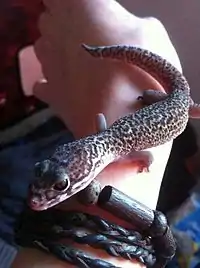| Central American banded gecko | |
|---|---|
 | |
| Scientific classification | |
| Domain: | Eukaryota |
| Kingdom: | Animalia |
| Phylum: | Chordata |
| Class: | Reptilia |
| Order: | Squamata |
| Family: | Eublepharidae |
| Genus: | Coleonyx |
| Species: | C. mitratus |
| Binomial name | |
| Coleonyx mitratus Peters, 1863 | |
The Central American banded gecko (Coleonyx mitratus) is a species of moderately-sized gecko in the genus Coleonyx, native to Central America and first identified by Wilhelm Peters in 1863.[2] It is a member of the eyelid geckos.
Description
Length (including tail) reaches 190mm, with the tail encompassing 50-54% of the total. As indicated by their name, these geckos have brown, black and yellow horizontal bands on their dorsal surfaces.
Biology
The Central American banded gecko is crepuscular and hides in a burrow in the soil during the day. It emerges at dusk to forage for insects. If threatened, like most geckos, it can lose its tail. Most will regenerate lost tails within a year.[3]
Distribution
These geckos are found from Guatemala south to Costa Rica.[4]
In captivity
Central American banded geckos are popular as pets. A single Central American banded gecko can be housed in a 20-gallon terrarium.
See also
References
- ↑ Chaves, G.; Porras, L.W.; Solórzano, A. (2013). "Coleonyx mitratus". IUCN Red List of Threatened Species. 2013: e.T203047A2759368. doi:10.2305/IUCN.UK.2013-2.RLTS.T203047A2759368.en. Retrieved 18 November 2021.
- ↑ Savage, Jay M. (August 1, 2002). The Amphibians and Reptiles of Costa Rica: A Herpetofauna between Two Continents, between Two Seas. University of Chicago. pp. 481–482. ISBN 978-0226735375.
- ↑ "Central American Banded Gecko".
- ↑ "Home Page".
